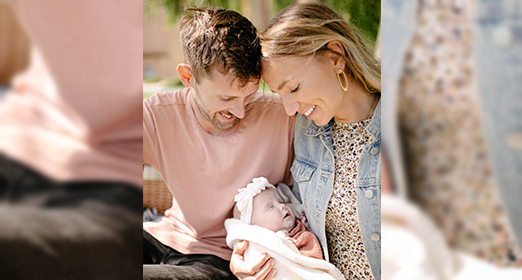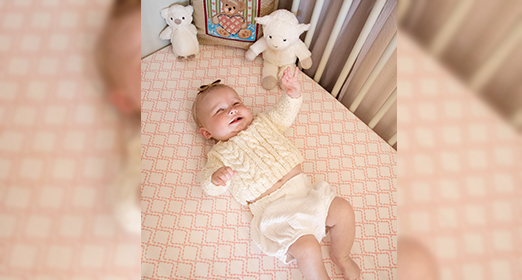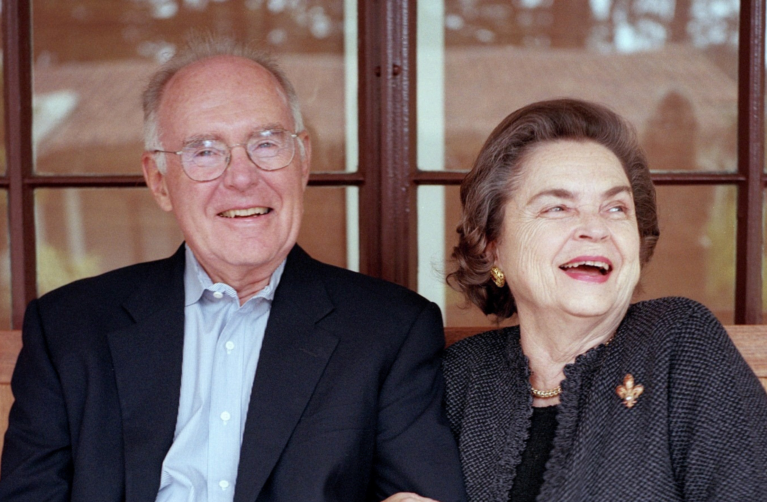When Bronte Benedict was born last October, everything seemed to go as expected. She loved to be held and to go for walks in her stroller with her parents, Marvin and Amanda, near the family’s home in San Francisco.
A week later, the Benedicts took Bronte in for a routine checkup. They expected to hear the usual—how long she was and how much weight she’d gained. Instead, their pediatrician detected a fast heartbeat and rushed them across the street to California Pacific Medical Center, which works in partnership with Lucile Packard Children’s Hospital Stanford. A cardiologist did an ultrasound-guided electrocardiogram and said Bronte’s heart was beating much too quickly. Bronte was put in an ambulance and taken to Packard Children’s.
“We went straight to the Cardiovascular Intensive Care Unit, and within three minutes, a team of 15 to 20 doctors, nurses, and technicians was around her,” Marvin says.
Doctors determined that Bronte’s heart was structurally sound, but she had a dangerous type of arrhythmia—not just in her upper chamber, but also in her lower chamber—which has been known to cause death in infants.
“Everyone went above and beyond,” recalls Amanda. “One nurse held and rocked her all night long. The team did a wonderful job educating us and including us in all their decisions. We felt like we had a voice the whole time. We called Packard Children’s Hospital home by the time we left.”
“At no point did we feel rushed,” adds Marvin. “There were a thousand medical terms, but they would patiently sit down and explain them to us. One doctoral fellow had a tattoo of the heart condition she was most intrigued with. That really struck me. I thought, ‘These people are not messing around.’”
Getting the Right Rhythm
Doctors gave Bronte medicines to control her abnormal heart rhythm, which seemed to work at first. Then, at 3 weeks old, her heart began to beat dangerously fast, despite the medicines. The safest thing to do, doctors decided, was to place an automated implantable cardioverter defibrillator (ICD).
“I call an ICD a ‘pacemaker plus.’ It not only recognizes a slow heart rhythm and resets it, but also recognizes a fast heart rhythm and can give a shock when someone is having a life-threatening arrhythmia,” says Anne Dubin, MD, electrophysiologist and director of the Pediatric Arrhythmia Service at Packard Children’s. “Most of the time it does nothing—just sits, watches, and waits. It’s like an insurance policy.”
But Dubin notes a unique challenge for pediatric patients: “ICDs are made for 200-pound adults, not for 6-pound babies.”
Fortunately, Dubin’s colleague, cardiovascular surgeon Katsuhide Maeda, MD, has earned a reputation for being inventive and skilled at placing devices in tiny patients.
“It’s rare for hospitals to place ICDs in babies of this size. It’s simply too challenging,” Maeda says. “Other hospitals don’t have the luxury of having a highly knowledgeable and diverse team of pediatric specialists like electrophysiologists, cardiovascular surgeons, and geneticists, and all under one roof. That’s what makes Packard Children’s special.”
ICDs are about the size of an old flip phone, and they have two parts: wires (leads) and the generator itself. In adults, ICDs are placed below the collarbone, but in small babies, some as young as 3 or 4 days old, they are put in the abdomen. The leads are then sewn onto the surface of the heart.
“Because Bronte was so tiny, we didn’t know if we could place an ICD until we opened her chest,” says Maeda. “She is likely one of the smallest babies in the nation to ever receive an ICD. She was definitely my smallest.”
Family Finds Comfort
Amanda and Marvin appreciated getting updates while they waited in the cafeteria during the approximately five-hour surgery. Throughout their entire stay at Packard Children’s, the Benedicts noticed firsthand the degree to which doctors and nurses in the Betty Irene Moore Children’s Heart Center collaborate throughout a patient’s treatment.
The multilayered care they received went well beyond the team of top doctors who considered Bronte’s care from every angle. It also included nurses who would check in even when Bronte was not their patient, and child life specialists and occupational therapists who provided knitted caps, socks, and kind words—making the Benedicts “feel like we had 14 different grandmothers around,” says Marvin. That doesn’t even mention the family rooms with showers and beds, and a social worker to sort through insurance and emotions.
“We joked that it was a spa, not a hospital. There were so many resources that we never knew we needed but found them so necessary to have,” Amanda says.
Now the couple relies on Bronte’s ICD to do the worrying for them. Each night, data on Bronte’s heart is uploaded to the hospital, along with data from 400 other babies and children with heart monitoring devices. She has yet to need a shock, and her ICD is pacing less than half the time, which is a big improvement from when she left the hospital.
As self-described techies who both work at Google, Marvin and Amanda are very comfortable with the automated device that’s inside their daughter’s body.
“It allows us to sleep at night,” says Amanda.
Fortunately, for mom and dad, Bronte is a good sleeper. She recently moved into her crib in her own room, started eating solid foods (avocado is her favorite), and is reaching her developmental milestones like rolling and cooing.
“She is so chatty throughout the day and is hitting lots of different tones and pitches now,” says Amanda. “We joke that she is our little baby bird, just squawking the day away.”
Patients like Bronte and their families benefit from the life-saving research and clinical care at Packard Children’s. Support from donors including Gordon and Betty Moore, who gifted $50 million to the Heart Center, is essential to attracting and supporting top researchers who are working to improve the quality of life for children with heart disease. Their goal is to deliver the best overall outcome—from the ability for children to perform well in school to exercise and enjoy an active life into adulthood.
The family returned to Packard Children’s in March when Bronte had COVID-19.
“The cardiologists were shocked and so impressed that she only had a temperature one night,” Amanda says. “We joke that after what she went through during her first two months, she will be able to endure anything life throws at her. She’s our little fighter, and we could not be more proud of her.”
This article originally appeared in the Summer 2020 issue of Packard Children’s News.




